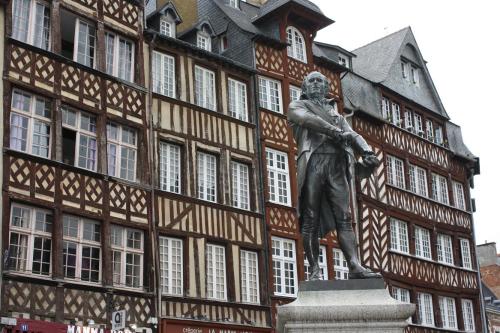
Rennes’ half-timbered homes. Photos by Richard Varr
Rennes, the scenic riverside capital of Brittany, is also a college town with 60,000 students. What impresses me most about this city with its 2,000 year history, however, is its half-timbered medieval homes and its sprawling and bustling Lices market, the second largest food market in France.
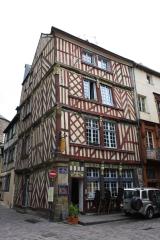
Photo by Richard Varr
Centered within Rennes’ cobbled medieval core, several hundred painted timber-framed houses remain – the highest number in Brittany. Many of the homes from the 15th through 17th centuries survived the massive 1720 fire that blazed for six days, destroying 33 streets and more than 900 homes. Today, the muted red, brown and yellow-streaked wooden facades of more than 280 homes are visible, as the others are still covered in plaster.
“After the fire of 1720, to protect the houses that escaped the fire, they covered them with plaster in the middle of the 18th century,” explains Rennes tour guide Sèverine Even as she leads us along the narrow streets. “In the 1970s, they removed the plaster to expose their original facades.”
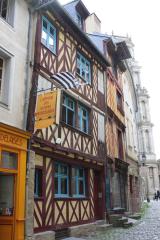
Photo by Richard Varr
Craftsmen find part of the original color on the homes to restore the facades to the original look, where crisscrossed and straight-patterned wooded beams are often adorned with brightly-painted window trims and carvings, especially over doorways. Carvings include motifs such as lions and stoic Roman soldiers. Businesses, restaurants, bars and shops now occupy the restored medieval buildings.
“Nowadays, it’s a quiet area and you can walk here freely,” says Sèverine. “It’s strange how Rennes still keep this medieval habit to have a lot of restaurants on one street and another street with bars – like in medieval times.”
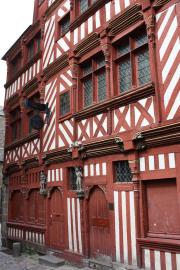
Ti Koz. Photo by Richard Varr
We pass by one building dating back to 1505 named Ti Koz, swashed in earthen-red paint. “It was a restaurant that burned down in the 1990s, but was rebuilt exactly the way it was,” says Sèverine. “It was a house for priests, but now it’s a pub. They saved whatever they could and rebuilt it. You can easily see the old parts like the statues around the door.”

St-Pierre. Photo by Richard Varr
The towers of Rennes’ St-Pierre Cathedral soar 44 meters over the surviving 15th century city gate, the Portes Mordelaises, and the adjacent crumbling medieval ramparts. The imposing cathedral we see today dates from the 16th to 19th centuries and includes a 5,000-pipe organ given by Napoleon III in 1857. The ceiling is typical of the 17th century with paintings surrounded by gilded wood and with a Brittany coat of arms in the middle. Another interesting church, the 15th century St-Yves Chapel with its Gothic architecture and original ceiling, is now home to Rennes’ Tourist Information Center.
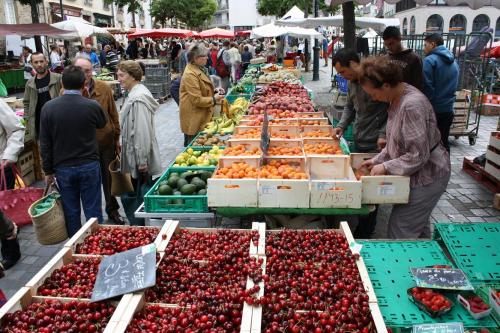
Lices Market. Photo by Richard Varr
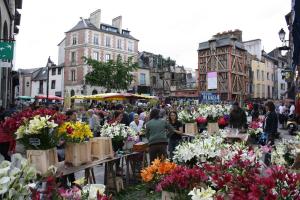
Flower Market. Photo by Richard Varr
I was lucky enough to be in Rennes on a Saturday – market day – to see a few hundred vendors and farmers from all over the region with cart after stall overflowing with produce, seafood and meats. I walk along a colorful cacophony of displays with roasting chickens, ripening bananas and strawberries, glistening red peppers and blooming flowers. With 120 kinds of apples in Brittany and Normandy, there’s also lots of cider, notes Sèverine. “This used to be a jousting square, but now they have the market. Everyone brings baskets to load up.”
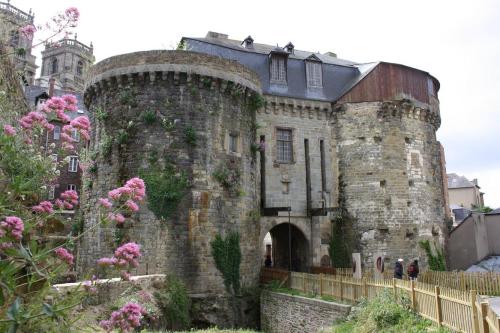
City Gate. Photo by Richard Varr
Other sights to see include Rennes’s 18th century City Hall on Place de la Mairie with the Opera on the other side of the square. Built a century after City Hall, the Opera’s rounded shape was designed to complement City Hall’s indented curved façade. “It’s like two pieces of a puzzle where one piece could fit into the other,” says Sèverine.
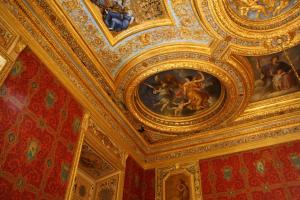
Parlement of Brittany Main Chamber detail. Photo by Richard Varr
The main chamber of the 17th century Parlement of Brittany building, restored after a 1994 fire, includes ornate and red-walled Parisian décor with French-style ceilings, chandeliers and gilded paneling. The tapestry, with a Brittany knight as the centerpiece, took six years to make. “We used to have tapestries on every single wall here,” says Sèverine. “They were saved during the 1994 fire and sent to a Paris workshop.”
“But the workshop burned so the tapestries we saved here were lost in the second fire in Paris,” she adds. “That was destiny.”
FOR MORE INFORMATION: www.tourisme-rennes.com
Le Château d’Apigné
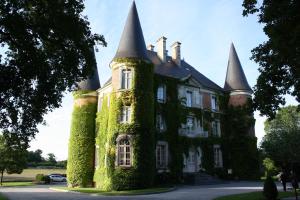
Le Château d’Apigné. Photo by Richard Varr
This elegant hotel on the outskirts of Rennes is a 10-15 minute drive from the city center. The chateau has spacious, well-adorned rooms that could give new meaning to the French countryside. During our visit, we learned French table etiquette from an expert, Madame Joëlle Ruault.
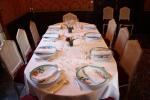 From Atout France: “Before working as the curator of a museum in Normandy, Joëlle Ruault taught visual arts in high schools in Rennes. Following her retirement, she has delved into exploring her passion for French heritage.
From Atout France: “Before working as the curator of a museum in Normandy, Joëlle Ruault taught visual arts in high schools in Rennes. Following her retirement, she has delved into exploring her passion for French heritage.

Madame Joëlle Ruault. Photo by Richard Varr
This passion, coupled with precision and diligence to her work, led her to propose this examination of the evolution from the Middle Ages to the modern era of l’art de vivre à la française, focusing on the culinary arts and table decoration. She was even invited to the Élysée Palace a few years ago where she talked about the protocol and l’art de la table in an official setting.”
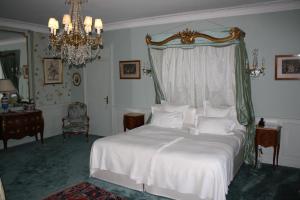
Le Château d’Apigné. Photo by Richard Varr
